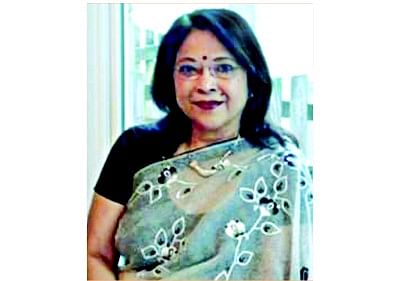The soul of a Tagorean

As she enters the room, Milia Ali is a picture of elegance in an embroidered white muslin sari with matching silver and gold golap bala (bangles). The former World Bank Education Specialist, now settled in the US with her husband Owaise Saadat, has another identity that she has just started to re-ignite. Through her music, Milia is introducing young ones in the musical world of Tagore songs.
As we settle into our conversation, Milia explains how she stepped into the world of music. After completing her Masters in Physics from Dhaka University and Development Economics from the University of Pennsylvania, she undertook a certificate course in Rabindra Sangeet from Shantiniketan in 1992-93. Prior to that, she had studied at Chhayanaut under music exponents Waheedul Haque, Phool Mohammad and Sanjida Khatun. In addition, she was also under the tutelage of classical exponents such as Ustad Mithun De and Munshi Raisuddin.
“I learnt more than just music under the legendary singers Kanika Banerjee and Nilima Sen at Shantiniketan; it was the Tagorean way of life -- where you let go and try to be less materialistic. Mohor di (Kanika Banerjee) would emphasise on the musicality rather than the technical aspect of a song. Her way of rewaz was simply humming the song till you internalise every note of the song,” says a nostalgic Milia.
“Regarding my formative period, I have fond memories of talented singers such as Maleka Azim Khan, Chaman Afroze and Farida Bari Malik singing Tagore songs on Boshonto Utshab. They were all part of my family, and initiated me into Tagore's music. My mother, Jannat Ghani, was a student of the renowned dancer Gawhar Jamil in the early '60s. She donned the main character in dance-dramas such as 'Shyama', 'Chitrangada' and 'Chandalika'. My father Qudrat Ghani, a music enthusiast, was a civil servant. Noted social activist, Mrs. Habibullah Bahar was instrumental in encouraging my mother to take up dance as an artistic vocation in those days when women were confined to their homes. This was in the '60s in Chittagong where I remember watching her perform during the Boshonto Utshab.
Though Milia is now in the US, her passion for Tagore songs has not waned. She has recently set up a music school, Geetali, in Virginia, Washington. While she teaches Tagore songs, Tumpa (daughter of noted artistes M.R. Benu and Shahin Samad), teaches the elementary courses of classical music.
“So far we have around six very talented and inquisitive children who attend hour-long classes,” she says. “The evening classes are for those who need to refine their skills. While not all of them can be performers, they can become good listeners.”
What is the aim of the school, I ask. “I plan to nurture and nourish the songs of Tagore across mainstream America. What struck me when I attended a programme in observance of the 150th anniversary of the bard, organised by the Indian community at the Smithsonian Museum, was that Bangladeshi artistes are far behind in the cultural front. Our embassies abroad need to project a wholesome image of our country that is embedded in our culture. We have our own entity which must be brought to light,” she responds.
According to Milia Ali, “Our children need to connect to their roots. With this aim in mind, we held a programme at the McLean Baptist Church on the 150th anniversary of Tagore where we had an in-depth discussion on Satyajit Ray's 'Charulata'. The discussion focused on the autobiographical aspects of the story, originally called Noshto Neer, and the great impact that his sister-in-law Kadambari's death had on Tagore's life and creativity.”
Milia now enjoys writing columns as well. “During my yearly visits to Bangladesh, what disturbs me is the distortion of language on the TV shows,” she adds with a touch of annoyance.
Milia has travelled extensively to all corners of the globe from Egypt to Indonesia to Armenia, Kazakhstan and Romania and now, the US. “I have never deviated from my identity; that is why my motivation is to introduce the young ones to be close to nature, and show them the reflection of nature in music. For example when we teach them Phooley Phooley Dholey Dholey, they can easily appreciate the lyrics. We discuss how spring brings about a change in nature. As music is relaxing for me, I enjoy working with students who see music as therapeutic,” says Milia smilingly.
Despite her travels far and wide, Bangladesh has been dearest to her. Just as we were finishing our conservation with her favourite memories of Bangladesh, I took out a picture I had retrieved from the archives. It was a black and white picture of a presentation by Chhayanaut students at the Central Shaheed Minar in 1969. Milia was overwhelmed. It brought back all the memories we had shared together as cultural activists during the tumultuous and embryonic stage of the birth of our country. Looking into her eyes, it was clear that despite being half a world away, Bangladesh and Bangladeshi culture were firmly etched on her heart. Heritage, as symbolised so powerfully by Chhayanaut, is what she still lives by. In this half century since its birth, Chhayanaut has been a sheet anchor in an upholding of our cultural identity. Milia Ali identifies with that story.

 For all latest news, follow The Daily Star's Google News channel.
For all latest news, follow The Daily Star's Google News channel. 



Comments